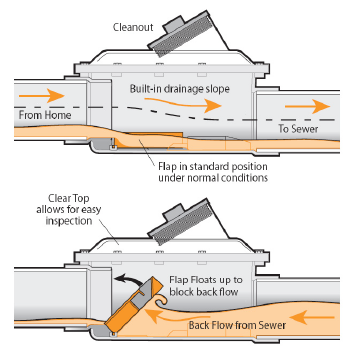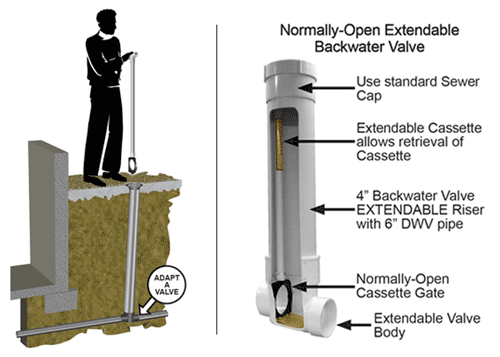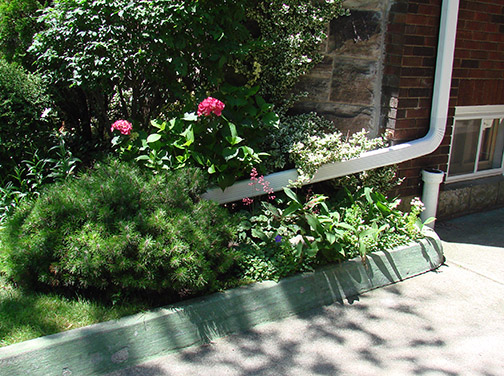Protective Plumbing Devices

For more information
Call 905-546-2489 or
Email [email protected]
For a water or wastewater emergency
Call 905-546-2489
During heavy rain storms, the sewer system can reach capacity and become overloaded. This increases the risk of basement flooding caused by sewer surcharge. The Protective Plumbing Program is part of the City’s strategy to help residential property owners mitigate basement flooding.
Backwater Valves
Basement flooding as a result of a sewer backup could occur if the sewer system becomes overwhelmed with stormwater during a heavy rain storm. By installing a backwater valve, property owners can effectively reduce the risk of basement flooding due to storm related sewer backups. Backwater valves are designed to only allow wastewater to flow in one direction, from your home to the city sewer. In the event of a sewer backup, the backwater valve flap closes, preventing anything from flowing in or out of your sewer until the sewer backup subsides and the flap reopens.
When a backwater valve is working during a sewer backup, wastewater is prevented from backing up into your basement. This also means that wastewater from your home cannot leave through the sewer while the valve is closed.

Backwater valves covered by the Protective Plumbing Program:
Mainline Fullport
The Mainline Fullport backwater valve is the standard backwater valve as shown in the pictures above. This valve is typically installed in basements where the sewer is less than 2 feet in depth and is located in an area that is accessible for servicing.
Adapt-a-Valve
The Adapt-a-Valve backwater valve was designed for homes where access to the sewer pipe is greater than 2 feet. It functions the same as the standard Mainline Fullport backwater valve but has a long access pipe which allows for easy access for cleaning and maintenance.

Backwater valves require regular cleaning and maintenance to ensure that the valve continues to function properly. You should check your backwater valve every 2 to 3 months or before a heavy rain storm.
The following items can clog pipes or tangle into massive knots that can damage the sewer, cause sewer backups and cause your backwater valve to not function properly. Please dispose of these items to protect the sewer system and your backwater valve.
- Baby or Hygiene Wipes
- Feminine Products
- Kitty Litter
- Dental Floss
- Diapers
- Condoms
- Hair
- Paper Towel
- Rags
- Food scraps
- Fat, Oil or Grease
- Paint
Backwater valves need to be checked every 2 to 3 months or before a forecasted heavy rainfall. This will ensure that the valve is functioning properly. Debris found in the valve will most likely prevent it from function properly. When conducting any maintenance, always wear protective gloves and eye protection.
Backwater Valve - Mainline Fullport
Most Popular Version. It’s generally installed in the basement of the house.
- Locate the backwater valve. It is generally in the basement in an access box in the floor.
- Due to potential contact with wastewater, please wear protective gloves and eyewear.
- Remove Access Box lid.
- Unscrew the Cleanout Plug on the top of the Backwater Valve so you can visually inspect the inside of the valve.
- Using a flashlight is suggested so that you can see the entire Valve Body.
- Look for debris build-up on the Valve Body, Valve Gate, and beneath the Valve Gate.
- If debris build-up is found, clean by flushing the valve with a hose or bucket of water.
- If deposits of grease or other debris remain, scrubbing may be required to remove deposits.
- Once the debris is removed, ensure that the Valve Gate can move freely. Do this by raising the Valve Gate and then lowering it back down to the open position.
- Reinstall the Cleanout Plug and ensure that it is tight.
- Repeat steps every 2 to 3 months and inspect before each forecasted heavy rainfall.

Backwater Valve - Adapt-A-Valve
Less Popular Version. This valve could be installed outside in the yard, driveway or in the basement.
- Locate the Adapt-A-Valve. It is generally in the yard, driveway or could potentially be in the basement. It may look like a typical sewer clean-out.
- Due to potential contact with wastewater, please wear protective gloves and eyewear.
- Remove Cleanout Plug.
- Using a flashlight is suggested so that you can see the entire Valve Body and Cassette Gate.
- Pull the 3/4" PVC Extendable Cassette up to remove the backwater valve Cassette Gate out of the body slot.
- Inspect Cassette Gate movement and o-rings on cassette to ensure that they are firmly set.
- Flush out any debris at the bottom of Valve Body.
- Carefully lower the 3/4" PVC Extendable Cassette and Cassette Gate back down the Extendable Riser and line up the back face with the fluorescent sticker on the Valve Body, this will guide the cassette into the Valve Body slots.
- Push gently down until the Cassette Gate stops and comes to rest with the bottom of the Valve Body.
- Apply a slight twisting motion to the 3/4" PVC Extendable Cassette to ensure the Cassette Gate is in the Valve Body slots (no twisting will be noticeable if the cassette is properly installed)
- If the 3/4" PVC Extendable Cassette twists at all, remove and begin the process again.
- Once secured, reinstall the Cleanout Plug or Access Box cover and ensure that it is tight.
- Repeat steps every 2 to 3 months and inspect before each forecasted heavy rainfall.

If you have difficulty maintaining your backwater valve, you may wish to consult a plumber or drain contractor to inspect and maintain your backwater valve.
Downspout Disconnections
If downspout disconnections are completed by one of the pre-qualified contractors, either in conjunction with the installation of a backwater valve or not, the property owner will be eligible for a reimbursement of $75 per downspout. The grant maximum is $2000 for any of the combined eligible works under the Program. Learn more about the Grant Program.
Sump Pumps
The installation of a sump pump may be beneficial in preventing basement flooding as the sump pump will transfer water from the basement to the ground surface outside the home. Where a new sump pump and pit along with a backwater valve is installed a total grant amount of $2,000 will be made available to property owners. This does not refer to, or include, the replacement of existing sump pumps or pits.
Please note, the City offers a Protective Plumbing Loan Program up to a maximum of $2000 to assist with eligible costs, including the installation of a sump pump in conjunction with the installation of a backwater valve, that exceed the Protective Plumbing Program Grant Program.

